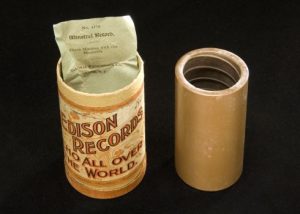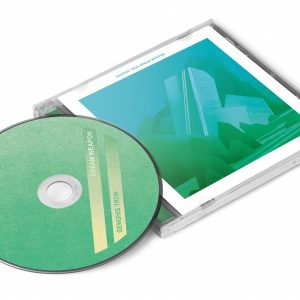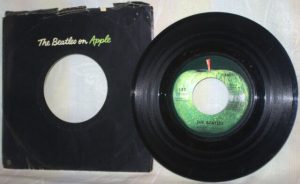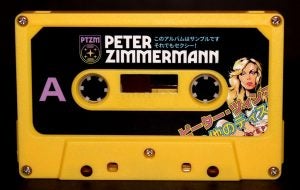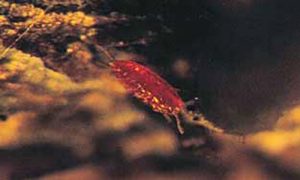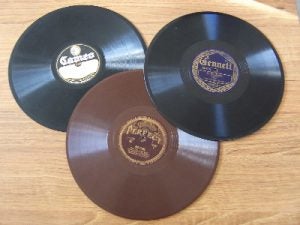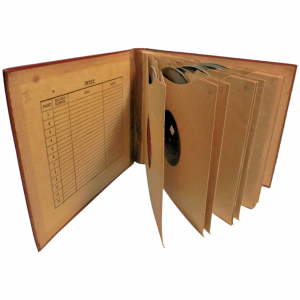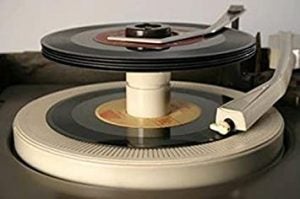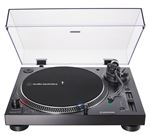A brief history of recording media
Most music listening today is done through audio files accessed via computers, smart phones or other portable digital devices. Before this all music and other sound recordings like poetry and audio books were reproduced and disseminated via a fixed medium – a portable object that could be encoded or impressed with audio information that needs a reproducing mechanism to be heard.
The earliest fixed medium for sound consisted of a wax coated cardboard or metal cylinder, commercially produced by Thomas Edison’s company beginning in the 1890s. Various other types of fixed media for sound recordings developed in the decades that followed, the materials for which could be anything that would stand up to multiple plays on sound reproduction machines.
Today the most common fixed media are the compact disc (or CD), which has digitally encoded music embedded on a plastic coated aluminum disc that is read by a laser beam and amplified electronically, and the similarly formatted digital video disc (or DVD). CDs first became commercially available in the mid-1980s shortly followed by DVDs in the early 90s.
Wax cylinder record on the right, outside of its case
Compact disc recording and jewel case
Before CDs there were (and are again) vinyl discs that rotate on a phonographic turntable at a specific speed (33 1/3 revolutions per minute for 12-inch long playing “albums” and 45 rpm for 7-inch “singles”). These discs have grooves scratched onto their surfaces analogous to the recorded sound which is transferred by a needle to an acoustical or electronically amplified system.
A 12-inch vinyl “album” and cardboard jacket
A 7-inch vinyl “single” by The Beatles with its distinctive green apple label and black paper sleeve
Concurrent with vinyl discs was magnetic celluloid tape upon which was encoded with analog (and later digital) audio information. “Tape” in various formats became commercially available after World War II. Due to its relative lack of playback noise, tape was beloved by audiophiles and recording engineers. In fact, up to the early 1990s, tape was the primary source medium from which vinyl discs were engraved. Beginning in the late 1960s the most popular tape format for home use was the audiocassette, with the Video Home System (VHS) videocassette for movies and other visual presentations coming in about 10 years later.
A 70s vintage audio cassette
However before tape and vinyl there was the 10 or 12-inch disc made of a shellac based compound that rotated at 78 rpm – today referred to as 78s. Shellac, like wax, is a natural product created by an insect, in this case the tiny female lac bug which draws the sap from certain trees found in the forests of India and Thailand excreting a resinous liquid over her body that hardens into a shell like structure into which, after fertilization, she lays her eggs. These shells build up on the branches of the trees from thousands of these lac bugs, providing enough resinous material for harvesting and processing into shellac which is mostly used for brush-on colorants (like nail polish), food glaze and wood finishes. But for 78s shellac acts as a binding element for a carbon powder mixture which was molded into discs with flat surfaces capable of being engraved for sound.
Lac bug in its larval stage
Lac resin on a branch
78s are fragile objects, easily broken when dropped, yet they were the main fixed medium for sound in the first half of the 20th century. They were sold as single records typically engraved on both sides of the disc (about 3 minutes length each side), frequently placed in albums (like photo albums) or kept individually in paper sleeves . Pre-packaged album sets by a particular artist or group of artists were also available for purchase.
10-inch 78 rpm shellac discs
An album of “78s”
Eventually various synthetic compounds were developed to replace shellac which led to the invention of vinyl plastic in the late 1940s. Vinyl is flexible and doesn’t break when dropped like the compounds used for 78s did. With that advantage and with a quieter surface noise when played on a phonograph, vinyl discs essentially replaced 78s by the mid 1950s and remained a popular fixed medium well into the 1980s, making a comeback in recent years.
The 12-inch 33 1/3 rpm vinyl discs became known as “albums” because they contained as much music or spoken word as a whole album of 78s. Columbia Records was the first to come out with these longer playing discs, coining the term LP (Long Playing) for their product which soon became synonymous for all 12-inch albums.
At first the album format was for Broadway cast recordings and classical music, but it wasn’t long before all sorts of music became available on long playing albums (see the Hawaiian music album pictured above). However, for the most part, the 7-inch 45 rpm vinyl disc, which RCA developed contemporaneously with Columbia’s LP, remained the main outlet for popular music during the 1950s and 60s. It carried over the same format as the earlier 78s – a “hit” song on the A side and another song that may or may not be as good on the B side.
An Edison cylinder phonograph
A disc-playing phonograph from the 1920s
A steel needle on a 78 rpm record
A 1950s phonograph playing a stack of 45s.
The tone arm tracks towards the center of the disc where the music ends
then lifts and returns beyond the outer edge as the next record automatically
drops down onto the turntable.
A modern turntable for playing vinyl records
Hip-hop artist, DJ Scratch, manipulating and mixing the sound of two LPs to make new music from pre-existing materials
78rpm recordings in the Music Resource Center
There is a small collection of 78s in the URI Music Resource Center which you can listen to thanks to a donation by Mary Oliver, the widow of Boston University collaborative pianist Philip Oliver, who gifted a record player that plays multiple speeds including 78rpm along with good deal of piano and instrumental solo sheet music.
The records themselves, both in albums and as individual discs, mostly came from the late URI Music professor Arthur Motyka’s collection, donated by his former wife Ginny Eastman. Dr. Motyka started the Music Department’s jazz program at URI in the early 1970s. The Armenian and other old pop records were donated by URI Music alumnus Charles Kalajian. A few came from various other donations.
Please contact Gerry Heroux in the Music Resource Center if you’d like to schedule a listening session to hear these discs in a real acoustic environment. However we can take advantage of the digital/crowd sourced world we live in and listen to many these discs from online posts at our leisure via the YouTube or Internet Archive links below.
JAZZ SINGLES
Terry Gibb’s New Jazz Stars
(New Jazz 800)
Charlie Ventura and his New Orchestra
(National Records 7015)
Please Be Kind – vocal by Lilyann Carol
Charlie Ventura and his All Stars
(Castle Record Co. – Sittin’ In With_504)
If I Had You – Baritone sax solo
Euphoria – Voices and tenor sax ensemble (“An experiment recorded June 1946”)
Dave Lambert with vocal group and rhythm
(Capitol 3401)
When the Red, Red, Robin Comes Bob, Bob, Bobbin’ Along – Bop vocal chorus with rhythm
Beban Cubop – Bop vocal chorus with rhythm
Dave Lambert with vocal group and rhythm
(Capitol 3404)
Hawaiian War Chant – Bop Vocal Chorus with Rhythm (1st half of the YouTube post)
Always – Bop vocal chorus with rhythm (2nd half of the YouTube post)
Dave Lambert Trio c/w The Five Bops
(Castle Record Co. – Sittin’ In With_508)
Dave Lambert Trio – featuring Allen Eager, tenor sax ; Bennie Green, trombone
Deedle – Vocal by bop trio
The Five Bops
Hot Halavah – Instrumental with vocal bop
Jo Stafford with Dave Lambert and his Vocal Choir, with Paul Weston and his Orchestra
(Capitol 4131)
M + H + R x 3ee – 00 / 4/4 aa³ X 32 = Bop (aka “Jolly Jo”)
The Roy Kral – Jackie Cain Sextet
(Atlantic 664 – Jazz Series 306/308)
Auld Lang Syne – Bop vocal by Jackie Cain and Roy Kral
Ever Lovin’ Blues – Bop vocal by Jackie Cain and Roy Kral
Howard McGhee Orchestra
(Dial 1027) “12-3-47 Contemporary American Music”
Lord Nelson and his Boppers
(King 4235)
Venerable Music site lists this as “Sonny Stitt as Lord Nelson, Milt Jackson along with Willie Willis and Jimmy Glover.”
Allen Eager with the Be Bop Boys
(Savoy 908)
Chubby Jackson and his Knights
(Century 1506) “For home use only – not licensed for broadcast”
A Knight in the Village – Parts 3 & 4
A live recording from a late 1940s/early 1950s club date – featuring Flip Phillips, tenor sax, Bill Harris, trombone, Lennie Tristano, piano, Billy Bauer, guitar, Chubby Jackson, bass and Denzil Best, drums. Audio taken from a later lp issued under Harris’ name. Tristano who was to develop a more cerebral cool style is in full swing mode here.
Chubby Jackson and his Fifth Dimensional Jazz Group
(Rainbow Records 10093)
Chubby Jackson and his Fifth Dimensional Jazz Group
(Rainbow Records 10098)
Hal McIntyre and his Orchestra
(Cosmo 475)
The Gypsy – Vocal refrain by Frankie Lester
Cement Mixer (Put-Ti-Put-Ti) – Vocal refrain by Nancy Reed
Serge Chaloff and the Herdsmen
(Futurama 3004)
Chasin’ The Bass – featuring Oscar Pettiford, bass
Buddy Stewart and his Quartet
(Castle Record Co. – Sittin’ In With_512)
Laughing Boy – Vocal by Buddy Stewart
Shawn – Instrumental (bop vocal)
The Poll Cats, directed by Eddie Safranski
(Atlantic 864)
ARMENIAN SINGLE
Paul Bohgian
(Armenairs APS-1421/1422)
Ay Vart [Oh Rose] – vocal with piano accompaniment
Hair Mer – vocal with organ accompaniment
Armenian religious hymns
JAZZ ALBUMS
NBC’s Chamber Music Society of Lower Basin Street
(Victor P-56)
Dr. Henry Hotlips Levine and his Barefooted Dixieland Philharmonic ; Maestro Paul Laval and his Woodwindy Ten ; Mademoiselle Dinah Shore, guest artist ; Professor Sidney Bechet, guest artist.
https://www.youtube.com/watch?v=NRpK-fGn8Mw
NBC’s Chamber Music Society of Lower Basin Street Vol. II
(Victor P-86)
Featuring: Dinah Shore, Paul Laval and his Woodwindy Ten, Henry Levine and his Dixieland Octet
https://www.youtube.com/watch?v=61tIzGB2z1E
Dixieland Jazz Group of NBC’s Chamber Music Society of Lower Basin Street:
The Birth of the Blues, an album of W.C. Handy music
(Victor P-82)
Henry Levine, conductor ; Lena Horne, guest soloist
https://www.youtube.com/watch?v=2LPKZI1rU6o
Innovations by Boyd Raeburn and his Orchestra
(Jewel D-1)
Body and Soul – w/Ginnie Powell, vocals
Blue Echoes – w/David Allyn, vocals
Temptation – w/Ginnie Powell, vocals
A modernist approach to Big Bands similar to Stan Kenton.
Bebop: An Album of Modern Jazz
(RCA Victor P 226)
Dizzy Gillespie and his Orchestra
Coleman Hawkins and his Orchestra
Kenny Clarke and his 52nd Street Boys
Lucky Thompson and his Lucky Seven
Decca Presents Gems of Jazz: A Series of Superb Jazz Classics, vol. 2
(Decca Album 201)
Gene Krupa and his Chicagoans
Blues of Israel – featuring Israel Crosby, bass
Bunny Berigan and his Blue Boys
Pete Brown and his Jump Band
Jess Stacy, piano with Gene Krupa, drums and Israel Crosby, bass
Jess Stacy, piano
1. In the Dark 2. Flashes [Bix Beiderbecke]
Ted Heath and His Music: London Suite by Thomas (Fats) Waller
(London LA 6)
https://archive.org/details/78_whitechapel_ted-heath-his-music-fats-waller
Chelsea
Whitechapel
Limehouse
Bond Street
Piccadilly
Soho
Vox Presents – WNEW Saturday Night Swing Session Off the Air volume 2
(Vox VSP 310)
3 discs in album (disc one missing): Sweet Georgia Brown, parts 1-3, High on an Open Mic, parts 1-3.
Featuring Fats Navarro, trumpet and Buddy Rich, drums
https://www.youtube.com/watch?v=lCJFH44qcZA
The YouTube link for “Sweet Georgia Brown” is from a later LP version that combines all the parts (Vogue L.D.E. 021)
https://www.hungama.com/song/high-on-an-open-mike/25162690/
This link for “High on an Open Mic” might be from the same recording but it is more likely the same group recorded on air from the WNEW radio show.
Giants of Jazz: Music from the Samuel Goldwyn production “A Song is Born” starring Danny Kaye and Virginia Mayo [featuring Louis Armstrong, Tommy Dorsey, Charlie Barnet, Benny Goodman, Mel Powell – album sales benefit the Damon Runyon Memorial Fund for cancer research]
(Capitol CC 106)
Golden Gate Quartet, Jeri Southern, The Brazilians, Benny Goodman, Tommy Dorsey, Charlie Barnet, Louis Armstrong, Mel Powell, and Orchestra
A Song Was Born (Parts 1 and 2)
Page Cavanaugh Trio w/ Jeri Southern, vocals, and orchestra
Charlie Barnet and his Orchestra
Benny Goodman Septet
Mel Powell Septet
Kansas City Jazz
(Decca Album 214 – Popular Series
Pete Johnson’s Band
Joe Turner and His Fly Cats
Mary Lou Williams and Her Kansas City Seven
Oran “Hot Lips” Page and His Band
Count Basie and His Orchestra
Good Morning Blues – vocal chorus by James Rushing
Eddie Durham and His Band
missing one record from the Kansas City set, replaced by:
Nappy LaMare’s Louisiana Levee Loungers
(Capitol Criterion 10025 – The History Jazz – 9)
Hazel Scott: Her Second Album of Piano Solos with Drums Acc.
(Decca Album no. 321 – 18 M Series)
Tesch: Chicago Style Clarinetist – Frank Teschemacher in a collection of Jazz Classics
(Brunswick Collectors’ Series, Album No. B-1017)
Chicago Rhythm Kings
There’ll Be Some Changes Made – vocal chorus by Red McKenzie
Baby Won’t You Please Come Home – vocal chorus by Eddie Condon
Joe “Wingy” Manone and His Club Royale Orchestra
Trying To Stop My Crying – vocal chorus by “Wingy” Manone
Elmer Schoebel and His Friar’s Society Orchestra
The Cellar Boys
Barrel House Stomp – second master
No records from this album were in the sleeves, but a brochure was present listing the album contents.
All the records in the sleeves of the Frank Teschemacher album are actually from the following album.
An Anthology of White Jazz
(Decca album no. 183, sides 3-8, 11 & 12 from a 12-side set).
Bob Crosby’s Bob Cats
New Orleans Rhythm Kings
Glen Gray and the Casa Loma Orchestra
Dorsey Brothers’ Orchestra
Adrian Rollini and His Orchestra
Bud Freeman and the Summa Cum Laude Orchestra
Joe Venuti and his Blue Four
ALBUMS in VARIOUS STYLES and GENRES
Music Out of the Moon: Music Unusual featuring the Theremin, themes by Harry Revel,
vocal group and orchestra conducted by Leslie Baxter
(Capitol CC 47)
https://www.youtube.com/watch
Jean Sablon: Songs of Paris sung in French
(Decca 305)
with orchestra conducted by Paul Baron
Margaret O’Brien, a Metro-Goldwyn-Mayer star: Stories for Children with Sound Effects and Incidental Music
(Capitol CC 21)
https://archive.org/details/78_the-three-billy-goats-gruff-part-2_margaret-obrien_gbia0020249
(Three Billy Goats Gruff, Parts 1-4 ; The Town Musicians, Parts 1 & 2)
Square Dances with and without calls
(Asch Records A 34)
Music by Mr. and Mrs. Siller, Tiny Clark, caller
https://www.youtube.com/watch?v=2BOp3ZonJJs
This is a pre-Folkways record by producer and Folkways Records founder Mo Asch
Alec Templeton: An Album of Piano Solos
(Decca 314)
https://archive.org/details/78_
Summertime (Gershwin)
It Ain’t Necessarily So (Gershwin)
Blues in the Night (Arlen)
Grieg Concerto in A minor, op. 16 (a solo piano arrangement that starts with the themes as written but eventually becomes a jazzy swing version)
Tchaikovsky 6th Symphony (Pathetique): 1st movement – Andante
Sleepy Lagoon (Eric Coates/Jack Lawrence)
Alec Templeton was a blind Welsh pianist and composer who made a career in the US on radio and later TV performing a mix of classical and jazz styles. His music was performed by Benny Goodman and others. His biggest hit was “Mr. Bach Goes to Town.”
Al Jolson Souvenir Album
(Decca 575)
With orchestra directed by Morris Stoloff
https://archive.org/details/78_al-jolson
Waiting on the Robert E. Lee
When You Were Sweet Sixteen (with vocal quartet)
Golden Gate
I’m Sitting on Top of the World
Carolina in the Morning
Liza (All the Clouds’ll Roll Away)
missing from album:
https://archive.org/details/78_back-in-your-own-back-yard_al-jolson
Toot, Toot, Tootsie
Back In Your Own Backyard
Instead of the Toot, Toot Tootsie/Back In Your Own Backyard disc listed above, there’s a record made up of sides 3 & 4 of the album, Fred Waring Music – Jerome Kern Songs by Fred Waring and His Pennsylvanians (Decca A-500)
Smoke Gets In Your Eyes (Kern/Harbach) – glee club and orchestra
Yesterdays (Kern/Harbach) – glee club, Jane Wilson, soloist
The Red Army Chorus of the U.S.S.R. Conducted by A.V. Alexandrov
(Keynote Recordings album no. 103)
https://archive.org/details/78_tachanka_red-army-choir-of-the-ussr
If War Breaks Out Tomorrow
Tachanka
Meadowland w/trumpet solo K. Lemeshko
Along the Hills and Vales
From Border to Border (not uploaded to this site)
Cossack’s Song (not uploaded to this site)
Snowstorm, soloist V. Pankov
The Young Birds Tree, soloist V. Pankov
Miscellaneous Album No.1
Sid King and the Five Strings (The King Brothers)
(Columbia 21449)
According to the Rockabilly Hall of Fame website Sid King was the first to “create, record, and play rockabilly music …(1952)”
The Music Box Medley of Christmas Songs
(Bornand Music box Record Company E1-LKB-2755/2756)
https://www.youtube.com/watch?v=PIQbwX68Iqs
10 inch 33 1/3 rpm lp produced by a division of the Bornand Music Box Company, Pelham NY, a family owned manufacturer of music boxes that started in Switzerland in the 1860s.
The Harptones, directed by Morty Craft
(Bruce Record Co. 104)
I Depended on You – vocal by Nicky Clark
Mambo Boogie – vocal by Dicey
Doo-wop/jump blues
Jackie Riggs, vocal
(Media Records 1020)
Pop vocal
Tom & Dan
(Unique Records 365 [113])
Piano instrumental
Rusty Draper with Hugo Peretti and his Orchestra
(Mercury 704460)
Pop vocal/Dixieland swing
Bonnie Sloan
(Columbia 21502)
A Cash Box Magazine readers’ poll had Bonnie Sloan in eighth place as “Most Promising Female Country Vocalist of 1955,” finishing one above rockabilly legend Wanda Jackson. Kitty Wells was first place, and last place…country superstar Patsy Cline! Sloan’s career, however, “never went national” according to one web source, though her recordings can be found online and in classic country music anthologies.
Jerry Vale with Percy Faith and his Orchestra
(Columbia 40499)
Pop vocal
Jimmie Byron
(Teen 113)
Jump blues styled pop
Chris Connor, with Jim Bright Orchestra, arr. Sy Oliver
(Bethlehem B 1291)
Gimme, Gimme, Gimme, Gimme, Gimme (The Miser’s Serenade)
Big band vocal ballad backed with a novelty number from this unjustly neglected jazz/pop singer.
Decca presents a group of authentic Armenian Folk Songs and Dances: Oriental Series Volume I
Nicolas Matthey (violin) and his Oriental Orchestra
(Decca Album no. 68)
Hail to Antranic (Armenian Patriotic Song)
Wedding Dance
The Morning Tea /The Fruit Vendor
Sweetheart
Lullaby
Rangui/Tashn Tchors
The Stork
The Sweet Vendor/Down in the Valley
Only two titles available online
Miscellaneous Album #2 (mostly Armenian)
A.Shah-Mouradian, tenor Hayasdan
(Columbia 28014-F)
Armenian national songs
Alyce Arabian, soprano (Suni) accompanied by Esther Scrabian
(Sayat-Nova AM-909)
Nanni Bala
Lorig
Suzanne Kachuni, soprano accompanied by Trio Caucasianne
(Sayat-Nova AM-906)
Kolkhozi Aghchik
Pokrik Tghan Mi Vard Tessav
Suzanne Kachuni, soprano accompanied by Trio Caucasianne
(Sayat Nova AM-907)
Volor-Molor
Yes, Poojoor, Yares Poojoor)
Vahan Boyajian (artist? producer?)
(Bilbil Record C-2 b/w Bilbil Record no. 4 A-0028)
ԳԱՑԵՐ ԵԱ ՇՈԻԿԱՆ (GAC̕ER EM ŠOIKAN)
ԿԱՁԷԼ (KAJEL)
Nelson Eddy, baritone with Nathaniel Shilkret and Orchestra
(Victor 4280)
I’m Falling In Love With Someone (from “Naughty Marietta”)
Tramp, Tramp, Tramp Along The Highway (from “Naughty Marietta”)
Unknown artist
Wo Ist Der Mann
Ja, So Bin Ich
Non-commercial pressing, recorded at Dailey’s Lab 6/14/41 (from labels)
A.Shah-Mouradian, tenor
(Columbia 28016-F)
Hishestsouk-Kisheri
Ourakh Ler
Armenian religious songs
Mr. “X” [vocalist] with orchestra (Side A) ; Charles Dale [vocalist] (Side B)
(Grey Gull 2233)
Always (Irving Berlin)
I’m in Love (Butler-Bishop)
Grey Gull was a Boston record company specializing in budget priced pop music by their in-house musicians and writers. Artists contracted to other record companies would use pseudonyms when recording for Grey Gull.
Miscellaneous Album #3
Victor 19965
International Novelty Orchestra
Cossack Love Song (Don’t Forget About Me) – from the musical play “Song of the Flame”
Jean Goldkette and His Orchestra
Behind the Clouds (There’s Crowds and Crowds of Sunbeams) – foxtrot
Madison 22004
Maryland Ramblers
Yes Sir, That’s Love – foxtrot
Dixie Troubadours
See Saw Susan – foxtrot
Grey Gull 1391
Metropolitan Dance Orchestra
Because I Love You – foxtrot
Paul Bolognese and His Orchestra
My Radio Romance – foxtrot
Cameo 821
Nathan Glantz and His Orchestra
Help! (¡Ayuda!) – foxtrot
Bob Haring and his Orchestra
The Farmer Took Another Load Away Hay! Hay! – foxtrot w/ vocal refrain
The link for the “The Farmer Took Another Load Away Hay! Hay!” is for a recording by the Paul Whiteman Orchestra with vocals by Billy Murray, likely very similar to the Bob Haring side above.
Cameo 892
Bob Haring and His Orchestra
Tie Me to Your Apron Strings Again – foxtrot w/ vocal refrain
The Caroliners
Thanks for the Buggy Ride – foxtrot w/ vocal refrain
The link for “Tie Me to Your Apron Strings Again” is for a recording by Jack Chapman’s Orchestra which is of similar vintage to the Bob Haring side.
Cameo 620
Varsity Eight
Talking To Myself – foxtrot
Bob Haring and his Orchestra
Eliza – foxtrot
Perfect 12408
Paul Johnson
I Scream – You Scream – We All Scream For Ice Cream – comedy vocal
Henry’s Made a Lady Out of Lizzie – comedy vocal
Madison 1604
Dixie Troubadours
Baby Face – foxtrot w/ vocal chorus
Always Got The Blues – foxtrot
Grey Gull 2279
Bostonian Syncopators
Pretty Little Baby – foxtrot
Metropolitan Dance Players
Sweetheart Why Are You Mad – foxtrot
Eddie Zack and his Dude Ranchers – vocal by the Western Serenaders
(Dude Ranch Z-1003/1004)
Eddie Zack and his Dude Ranchers
(Dude Ranch Z-12)
Afraid – vocal, Cousin Richie
Mountain Polka – vocal, Babs
Eddie Zack and his family were for many years the leading exponent of country music in Rhode Island. He is honored with a membership in the Rhode Island Music Hall of Fame. Zack was of Armenian heritage, which explains his records being mixed in with the Armenian music in this album. http://rhodeislandmusichalloffame.com/site/?page_id=400
Lucy Armstrong, vocal ; James J. Johnson, arranger and director ; Russell Gasparian, producer
(Armenian Radio Hour 508)
Ay Ayli
Siroonig Siroonig
Russell Gasparian (1918-2010) hosted an Armenian cultural show, “The Armenian Radio Hour,” on local RI radio for over 50 years http://www.armenianradiohour.com
Miscellaneous Album #4
Paul Ash & His Orchestra
(Columbia 944-D)
Shanghai Dream Man – vocal chorus by Charles Kaley – foxtrot
Beedle Um Bo – vocal chorus by Johnny Marvin and Ed Smalle – foxtrot
The audio file for Shanghai Dream Man is by the California Ramblers, a group sounding similar to Paul Ash’s orchestra, recorded in the same year (1927) for the Perfect label.
Enric Madriguera and his Orchestra (Vocal chorus by Sarita Herrera)
(Columbia 35712)
Calientito – Rhumba
Adios – Rhumba
Enric Madriguera was a Catalan born classically trained violinist who lead a New York based Latin music group in the 1930s and 40s.
Nicolas Matthey and his Oriental Orchestra
(Decca 2717)
Lullaby
Rangui / Tashn Tchors – Armenian folk dances
Ethel Smith and the Bando Carioca
(Decca Personality Series 23462)
The Parrot (On the Fortune Teller’s Hat) (Os Pintinhos No Terreiro) – samba
Featured in the R.K.O. picture “George White’s Scandals”
1. Paran Pan Pin 2. Cachita – rhumba
Ethel Smith was a virtuoso Hammond organist, featured in movies during the 1940s.
 Home
Home Browse
Browse Close
Close Events
Events Maps
Maps Email
Email Brightspace
Brightspace eCampus
eCampus



